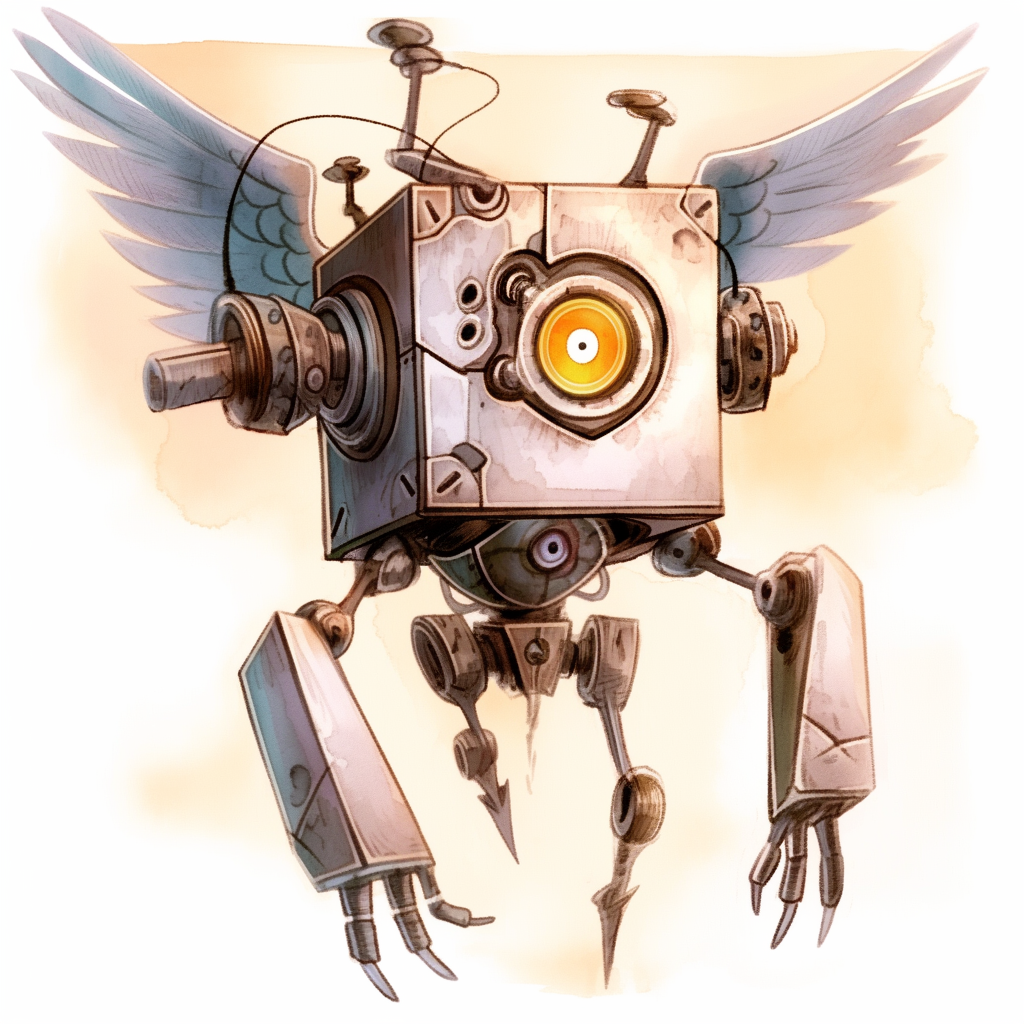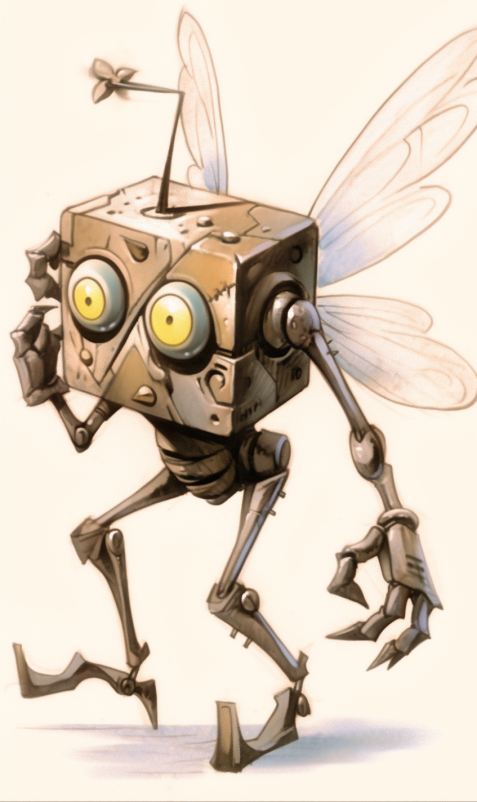[ Modrons ] [ Base: Monodrone | Duodrone | Tridrone | Quadrone | Pentadrone ] [ Hierarchs ]
Modron, Quadrone
by Axionis Vell, Scholar of the Fraternity of Order
Preface

On the Cusp of Cognition
The quadrone is almost certainly the most recognisable modron; the form that springs to mind when a cutter thinks of the race. This isn’t just because the quadrone is the most common form adopted by rogue modrons, therefore making them more common a sight in Sigil and around the Great Ring. It’s also because they are often the face of the modron empire for visitors to Mechanus. For the quadrone unit is something of a fulcrum, where the base modronic automatic mind finally yields to the flickering glow of intellect. If the monodrone is the hand, and the duodrone the arm, and the tridrone the instinct to control the arm, then the quadrone is the mind of the labour force of Mechanus. In the modron clockwork hierarchy, the quadrone serves as the bridge between the thinking and the reacting.
Quadrones are the first caste of modrons capable of true initiative. No longer mere conduits of orders, they can independently identify errors, strategise solutions, and modify their tasks to accommodate changing circumstance. In them, one sees the signs of mortal ingenuity, albeit absent of passion, creativity, or self-interest. Their singular drive is precision, their philosophy one of “adaptive obedience.”
Physical Form
The Perfect Cube of Function
The form of a quadrone embodies its purpose. A perfect cube with four-fold symmetry, forged from metallic plates interspersed with flexible joints. Four limbs extend from the cube’s edges, and typically each face of the cube bears an eye, granting them unparalleled all-around vision. This arrangement ensures that no threat or anomaly goes unnoticed. Unlike tridrones, who pivot and shift to observe their surroundings, quadrones possess a fixed omnidirectional awareness.

These eyes are not merely aesthetic accoutrements but functional sensors of some precision. A quadrone can see clearly in darkness and is immune to flaws of mortal perception, such as surprise or confusion brought on by being flanked. This form mirrors their cognitive role: they oversee work in all directions at once.
I should note here that while the basic form of the quadrone typically has one eye on each vertical face of the cube, not all modrons are configured this way. Some manifest with two eyes on the same face; perhaps in an attempt to emulate the typical configuration of mortal faces. It’s probably no coincidence that the quadrones in roles which require more interactions with fleshy humanoids tend to be of this form, while the battle cubes with more offensive roles typically present with eyes in the all-around configuration.
Their four limbs, unlike the simple grabbers of duodrones or the spidery limbs of tridrones, are strong, precise, and multi-functional. Some quadrones can wield two bows simultaneously, often firing in opposite directions, or alternate between ranged and melee combat. Some quadrones, adapted for aerial deployment, possess functional wings in place of one pair of arms, providing them with limited but effective flight. These winged quadrones act as rapid response units, sent where the modron army requires immediate intervention.
Role in Modron Society
The Foreman of the Gears
We have already discussed how the tridrones act as task coordinators. In this respect, the quadrone is a worksite foreman. In this role it directs tridrones, who in turn instruct duodrones and monodrones. This layered structure ensures that important orders issued by the hierarch modrons can be disseminated throughout modron society with speed and accuracy.
A quadrone can perform four tasks at once—an evolutionary leap compared to the dual-tasking duodrone or the singular focus of the monodrone. It is this capacity that allows quadrones to oversee entire projects, command legions of lesser modrons, and process battlefield tactics in real time. Unlike lower castes, which cease function if given contradictory orders, a quadrone can resolve ambiguities and identify logical paths forward, although it will usually query such orders with its pentadrone superiors for clarification.
Common Duties Performed by Quadrones
- Overseeing repair efforts on damaged gears or structures of Mechanus. Quadrones issue new instructions when anomalies are found, re-optimising for efficiency when unforeseen problems arise.
- Supervising large-scale modron labour efforts, such as the assembly of colossal engines, structures or fortifications during the Great Modron March.
- Serving as field officers in battle, where they lead large detachments of tridrones, duodrones, and monodrones, coordinating precise tactics and formations to encircle and overwhelm enemies.
- Notably, quadrones are the lowest caste of modron capable of direct command. While tridrones can organise duodrones and monodrones below them, they themselves require instruction. Quadrones, however, are granted the authority to issue new orders, adapt them to present conditions, and act with limited autonomy. As such, quadrones are often called “adaptive foremen”—individuals with enough cognitive awareness to problem-solve, but not so much that they might question the system itself.
Abilities and Traits

The most significant quality of a quadrone is its capacity to divide its attention between multiple tasks at once. It can supervise the tridrones beneath it, communicate telepathically with superiors, defend itself, and plan tactical manoeuvres—all simultaneously.
All-Around Vision: The sensory organs on all four vertical faces of a quadrone’s cubic form give it an unmatched field of view. No ambush, no flanking manoeuvre, no surprise attack can escape its perception. Opponents find it challenging to gain such a tactical advantage. In combat, this is crucial. Where tridrones dart around and twist to see threats, quadrones remain calm, still, and ever-watchful, responding to threats with brutal precision.
Repetitive Attack: Quadrones are versatile warriors. Their four limbs allow them to wield two bows or two weapons at once, and their sharp tactical minds allow them to identify key targets and focus their fire on the most vulnerable or tactically advantageous. Their training in ranged combat using longbows, allows them to attack at range without sacrificing effectiveness. The quadrone’s repetitive attack ability grants them a natural tactical advantage. If a quadrone targets the same foe across multiple consecutive rounds, and the foe does not move, the quadrone gains increased accuracy [+2 attack bonus] in the second and subsequent rounds. This reflects their relentless precision—the longer they focus on a target, the more deadly they become. It is a terrifying thing to be marked for elimination by a quadrone.
Command and Adaptation: The quadrone’s ability to issue orders makes it an essential link in the chain of command. Unlike lower modrons, who require orders to act, quadrones are allowed to adapt commands to fit the current situation. For example, if a tridrone reports a structural flaw in a Mechanus cog, a quadrone can immediately issue a corrective order to halt construction, call for repairs, and reschedule timelines. This flexibility is a profound departure from the rigidity of lesser modrons. This ability to both command and adapt is the reason why quadrones are often found leading repair crews and occupying roles of battlefield command. On the front lines of the Great Modron March, it is the quadrones who act as battlefield captains, issuing commands that lesser modrons cannot ignore.
Limitations
To a mortal scholar, the quadrone represents the first step on the ladder of free will. But the Fraternity of Order understands this for what it is: the illusion of free will. The quadrone’s logic is pre-programmed, its capacity for initiative carefully limited. It cannot ask, “Why?” It cannot ponder, “What if?” It can only evaluate, react, and proceed. The quadrone follows a model of deterministic flexibility. And this is essential—for it is the quadrone who for some reason do ask why who are at the greatest risk of going rogue. The quadrone is a precarious rank, for they have the capacity to reason but not enough information to comprehend the answers to all the questions they could ask.
Despite their efficiency, quadrones remain shackled to Mechanus’s greater design. They lack true intuition, relying instead on complex logic trees and protocols. While this allows them to address many unforeseen issues, they cannot grasp truly random or chaotic phenomena. For example, if a Xaositect were to randomly flip switches on a Mechanus control panel, a quadrone would not anticipate or predict this behaviour. It would respond only to the direct consequences of that action.
Quadrones are also hindered by their need for clear hierarchy. They will not assume command if a higher-ranking modron is present. In battlefield conditions, this can lead to moments of stagnation, as quadrones who are aware a superior is nearby may forgo their own initiative, instead awaiting confirmation before acting.
The Philosophy of the Quadrone
The Calculating Steward
A quadrone does not think as mortals do. It does not dream, ponder, or create. But it is aware. It understands that a task may require modification, and that outcomes do not always follow logical paths. Its philosophy, if it could be called that, is one of structured pragmatism. It embraces the concept that deviations in process are not necessarily flaws, but challenges to be surmounted.
Whereas lower modrons operate by rote, the quadrone possesses the ability to use conditional logic. If Task A is impossible, then attempt Task B. If Task B fails, report it to a superior. If no superior is available, attempt Task C. This is what elevates it beyond the ranks of its underlings.
Concluding Remarks
To the untrained eye, the quadrone is merely another metal automaton clunking across Mechanus’s endless cogs. But to the philosopher-scholar, they offer a glimpse into the concept of structured intelligence. Neither entirely free-willed nor entirely mindless, the quadrone occupies the liminal space between function and thought. A machine with just enough will to be dangerous, but just enough obedience to remain a slave.
The cube is the perfect form of balance. So too is the quadrone—a servant that can think, but never too much.
—Axionis Vell, Fraternity of Order, Clerk of the Ninth Sector of the Third Quadrant
Quadrone Statistics
- AD&D 2e — Original stats here
- D&D 3e — Manual of the Planes modron pdf web enhancement, rescued from the now defunct http://archive.wizards.com/dnd/files/modrons.zip
- D&D 5e — you can find official 5e stats for the monodrone in the 5e Monster Manual, with the absolute barest of descriptions. There’s a more detailed homebrew version here
- Pathfinder 1e — Nice conversion here from the Creature Codex here
- Pathfinder 2e — A great conversion here; and the original article on Reddit.
Canonical Sources
- Planescape Campaign Setting: Monstrous Supplement [2e] p16-19,22; great description of the race
- Dragon Magazine #354 [3e] p37-45; the ecology of the modron
- Great Modron March [2e] p8,25,126; duodrones feature throughout the book
- Planes of Law: Mechanus [2e] 13, 22 (2-3,29); how the modrons fit into the grand scheme of Mechanus
Source: Jon Winter-Holt


